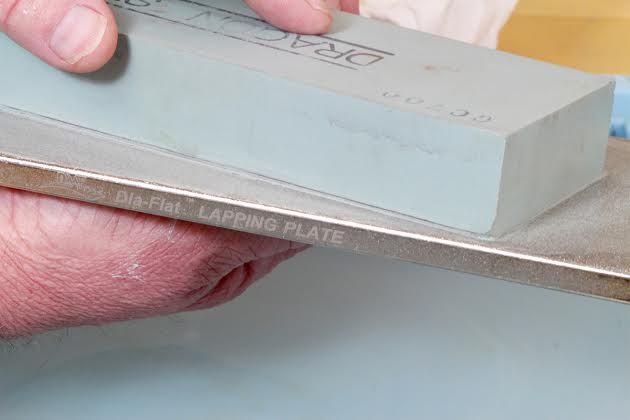Stan Watson is the technical director for DMT Diamond Machining Technology, www.dmtsharp.com
Many veteran woodworkers and craftsmen cling to waterstones as their preferred medium for tool sharpening. For some itís a matter of tradition, a practice passed down from generation to generation. Others simply find more enjoyment in the sharpening process when using waterstones. While there are more technologically advanced and efficient sharpening methods and media (e.g., diamond sharpeners), if you like using your waterstone, youíll want to maintain its flatness. Simply put, if it isnít flat, it canít deliver a proper edge to your tools.

Those who use a waterstone know it can quickly lose its flatness when used regularly. Some waterstones go out-of-flat quicker than others (e.g., softer grade stones, lesser quality stones), but all require regular maintenance to ensure peak performance. Many craftsmenómyself includedóbelieve a waterstone should be flattened prior to each use. But before you say, ďThatís way too much maintenance,Ē consider how a diamond tool can make the process quick and easy.
A diamond lapping plate provides a reliable solution to restore out-of-flat waterstones. But, just like waterstones, not all diamond lapping plates are created equal. Youíll want to do some basic research and comparison shopping before settling on one. For example, itís crucial that you know the grit of the waterstone you intend to flatten so you choose a diamond lapping plate designed to accommodate that grit. Youíll also want to select a plate that has a surface area large enough to easily accommodate your stone. And understanding the quality of the diamond coating and any certification for flatness is also key.
The flattening process itself is simple:
First, take a pencil and draw hatch marks, or xís, on the surface of the waterstone. This will help you know when the flattening process is complete, because the pencil marks will disappear.
Remember, because youíre trying to remove material in a uniform fashion, your waterstone must be wet. The water serves to remove the slurry necessary to restore the flatness. So, run the waterstone under the faucet or keep it submerged while flattening.
Next, using moderate pressure and a figure-eight motion, rub the waterstone over the surface of the diamond lapping plate, inspecting frequently to see when the pencil marks are erased. It doesnít take long. If itís been a while since youíve flattened the waterstone, the process could take two or three minutes; the more regularly you flatten, the quicker the process.
Always take care handling the waterstone. Sometimes these stones can chip, crack or break. Waterstones are also susceptible to damage if they get too cold, so never store them in the shed for the winter.
Waterstones are popular because they can cut fast, but the softness that allows for fast cutting is also what causes them to wear unevenly. If you choose a waterstone to keep your knives and tools sharp, itís a good idea to have a diamond lapping plate handy to quickly bring the flatness back.
Stan Watson is the technical director for DMT Diamond Machining Technology, www.dmtsharp.com